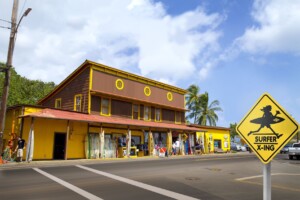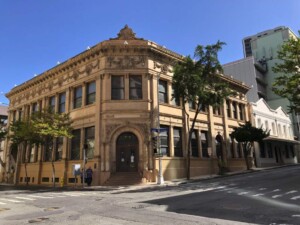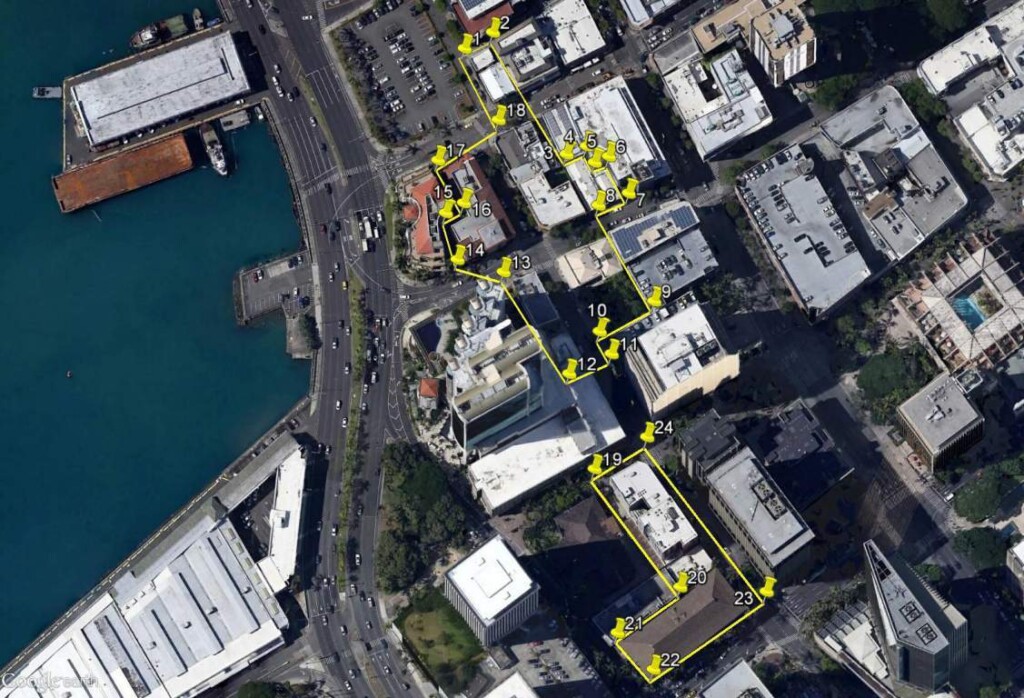The Hawai‘i Historic Places Review Board added two properties to the Hawai‘i Register of Historic Places in November 2021.
Properties are eligible for inclusion in the State and National Registers because of their association with broad patterns or events (Criterion A), or individuals whose lives are significant to our past (Criterion B). They are usually significant in architecture and design (Criterion C) or are likely to yield important information (Criterion D). Their features and other characteristics retain their qualifying integrity.
Click on the address/property name to view the property’s nomination form.
Surf n Sea Building, Hale‘iwa, O‘ahu

Photo is of the Surf n Sea Storefront, with Surfer X-ing Sign. Photo Credit: Surf n Sea.
Constructed in approximately 1921, the Surf n Sea Building is significant under Criterion C as a good example of a wooden commercial building constructed in Hawai‘i during the opening decades of the twentieth century. Stylistically, it is typical of its period in use of materials, method of construction, craftsmanship, and design. The building sits on a 3,780 square foot lot between Kamehameha Highway and Maeaea Beach and is located on a street lined with commercial buildings that contributes to the retail character of Hale‘iwa’s downtown core.
The principal exterior materials of the building are: wood, tongue and groove walls, a corrugated metal roof, and a concrete slab foundation. It is a two-story building that is characterized by a shed roof awning running the length of the façade between the first and second stories, as well as another situated above the second story windows. Although the building has undergone a number of alterations, it still retains its historic integrity and stands as one of the larger and more imposing historic buildings and also only one of two remaining two story examples of this building form in Hale‘iwa. It is a recognizable landmark in the North Shore community.
Merchant Street Commercial and Civic Historic District, Honolulu, O‘ahu (Amended)

Photo is of the Yokohama Specie Bank Building (fronting intersection of Bethel and Merchant Streets) with the Friend Building (fronting Bethel Street) in background.
The Merchant Street Commercial and Civic Historic District is located in downtown Honolulu. This district was first listed on the National Register of Historic Places in 1973. This amended form provides clarification of district contributing features, along with expanded description and significance sections, details the district’s history as well as its architectural character, and has added two buildings to the district (The Honolulu Star-Bulletin Building and the Alexander & Baldwin Building). Other new resources added to this district nomination are the site of the original Honolulu Hale and four objects: granite curbs and sidewalks, lava rock curbs, cannons, and a remnant of a cast-iron storefront.
The name of the district has been amended from “Merchant Street Historic District” to “Merchant Street Commercial and Civic Historic District” to distinguish this nomination from the previous one. The district is an excellent example of an early commercial center in post-contact, pre-territorial, and Territorial Hawai‘i. As one of the first official streets in Hawai‘i and one of the city’s first economic hubs, it is significant under Criterion A for its role as ‘Honolulu’s Wall Street’, the location of the Honolulu Stock Exchange, banks, insurance companies, sugar factors, and commission agents. Four out of the five members of the ‘Big Five’ maintained their offices in buildings included within the District. The District is also significant under Criterion C. It retains a notable concentration of intact, historic, commercial, and municipal buildings from the mid-19th to mid-20th centuries. The District is also significant under Criterion D as the site of the original Honolulu Hale, which yields important historical information from the Kingdom of Hawai‘i.
The Merchant Street Commercial and Civic Historic District occupies the three northernmost blocks of the street between Nu‘uanu Avenue and Bishop Street. In the amended form, all 15 buildings in the district were constructed between 1854 and 1931 as low- and mid-rise buildings of two to six stories. The materials are typical of the period and include brick, terra cotta, coral block, reinforced concrete, and lava rock.
The 15 buildings that make up the Merchant Street Commercial and Civic Historic District are: T.R. Foster Building (1891); Brick Warehouse (construction date unknown); The Royal Saloon (1890); J.T. Waterhouse Building (erected in 1870 and remodeled ca. 1911-1914); Yokohama Specie Bank Building (1908); The Friend Building (1887); Old Honolulu Police Station (1931); Melchers Building (1854); King Kamehameha V Post Office (1871); Bishop Bank Building (1878); Bishop Estate Building (1896); Judd Block (1899); Stangenwald Building (1901); Honolulu Star-Bulletin Building (1910/1911); and Alexander & Baldwin Building (1929).
There is one site and four objects that are part of this district as well, those are: Honolulu Hale (1836); Lava Rock Curbs; Granite Curbs and Sidewalks; Cannons; and Campbell Block Remnant (1898).
HHF has published a map of the Merchant Street Historic District, it will be released in PDF format soon.

Boundary Map, boundaries for Merchant Street Commercial and Civic Historic District.

